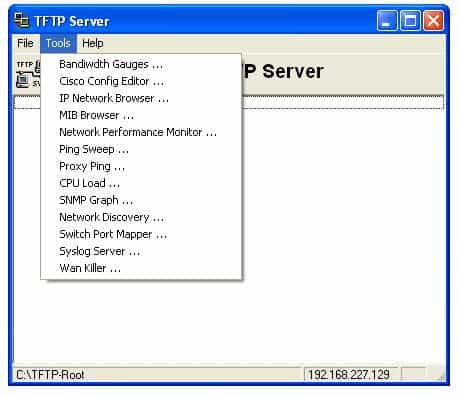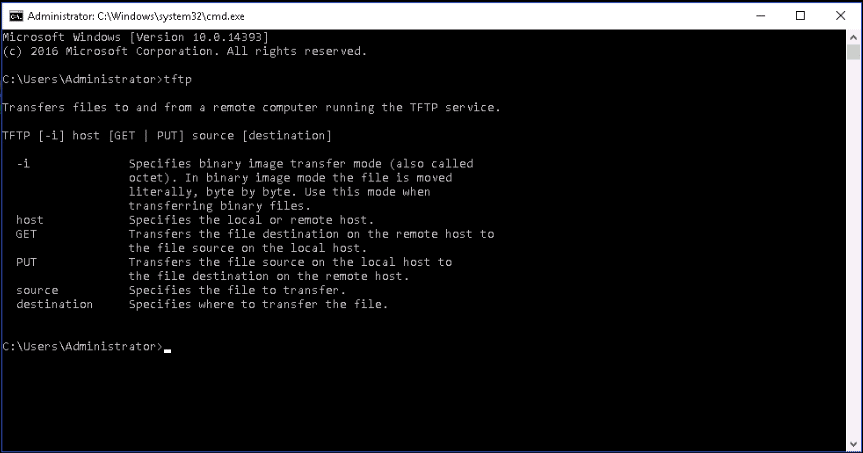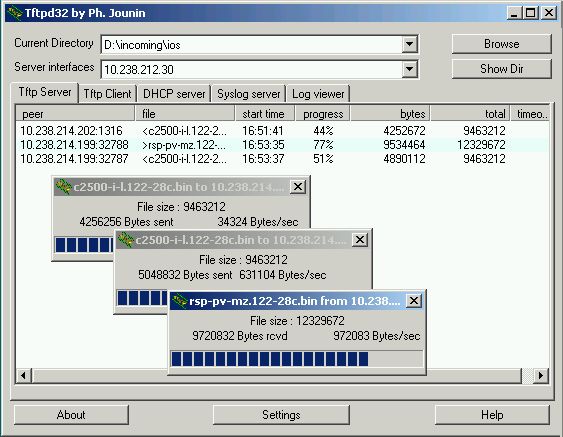

- #Tftp server windows how to#
- #Tftp server windows install#
- #Tftp server windows license#
- #Tftp server windows download#
You can follow the below steps to add an exception for the TFTP connections:ġ. Once you are finished, you can proceed to the next step.īefore using the TFTP client, you will need to turn off the Windows Firewall or configure the Firewall to allow the inbound/outbound transfer of files using the TFTP client.

This process will take some time to finish the installation. Click on the OK button to start the installation process of the TFTP client. Scroll down until you see the TFTP Client check box and CHECK it as shown below:Ĥ. This will open the Windows Features dialog box.ģ. Click on the Programs and Features => Turn Windows features on or off. Click on the Start Menu and click on Control Panel.Ģ.
#Tftp server windows install#
You can install the TFTP Client on the client computer by following the below steps:ġ. Now, you will need to install a TFTP Client on the Client computer. Once you are finished, you can proceed to the next step.Īt this point, the TFTP server is installed and configured. In the Permitted Transfer Types section, check the box “ Send and Receive files” and “ Allow All IP address to send/receive Files” and click on the OK button to finish the configuration. As seen in the screenshot above, Select the TFTP Server Root Directory field and provide the TFTP root directory, then click on the Security tab.Ĥ. Click on the File => Configure button as seen in the above Screenshot.ģ. Open the TFTP Server from the Start Menu as shown below:Ģ. You can follow the below steps to configure the TFTP server: Configure TFTP Serverġ. You will be asked to provide the location of the TFTP server as shown below:Ĭlick on the Next button to continue with the default location.Ĭlick on the Finish button to complete the installation.Īfter installing the TFTP server, you will need to configure it.
#Tftp server windows license#
You will be redirected to the License agreement page as shown below:Īccept the License agreement and click on the Next button. Once downloaded, extract the downloaded file and double click on the installer to start the installation, you should see the following screen:

#Tftp server windows download#
Install TFTP Server Windowsįirst, you will need to download the SolarWinds TFTP server from their download page:
#Tftp server windows how to#
In this tutorial, we’ll learn how to setup a TFTP server and a TFTP Client on Windows a system and also learn how to configure your Firewall to allow file transfer between the TFTP server and the TFTP client. However, sending or receiving sensitive files via the TFTP without authentication or encryption is very risky. TFTP protocol also allows the network clients to automatically obtain the IP address of the TFTP server thus making TFTP not only easy to implement but also provide a better way for file transfers. It is very useful for thin clients, terminals and disk-less workstations with no room to install their own operating systems. TFTP is used for its simplicity as it is specifically designed to read and write files without establishing a connection between the client and the server. TFTP cannot list directory and there is no error recovery like TCP and nor does it allow you to delete or rename files. It does not provide authentication and no command structure like FTP, SFTP and SCP. It is very useful for electronics circuit boards and microprocessors to download firmware into the chipset and its also used for transferring boot files and updating NVRAM. CISCO devices also use the TFTP protocol to store configuration files and images and move them to and from switches, routers and firewalls. Generally, TFTP is used to boot operating systems over the network.

It is commonly used in the place where security is not important and it has limited features compared to other file transfer protocols (FTP/FTPS/SCP). TFTP runs on UDP port 69 and does not use any security during the file transfer, thus its really only good for transferring files within your LAN. TFTP stands for “ Trivial File Transfer Protocol” is a simple and lightweight protocol for transferring files over the network.


 0 kommentar(er)
0 kommentar(er)
